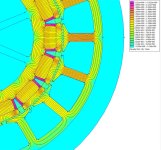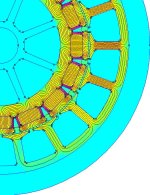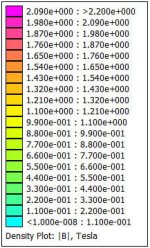Comparison between rotors with internally mounted and surface mounted magnets.
The stator core geometry was adjusted for the flux available from the rotor with internally mounted magnets (IM). It was retained as a constant for the comparison with the rotor having surface mounted magnets (SM).
Even with a magnet volume one quarter that of the IM rotor, the SM rotor still created a greater flux density in the stator core.
Conclusion: IM is not really suitable for high pole counts or, there's something wrong with my methodology....
The stator core geometry was adjusted for the flux available from the rotor with internally mounted magnets (IM). It was retained as a constant for the comparison with the rotor having surface mounted magnets (SM).
Even with a magnet volume one quarter that of the IM rotor, the SM rotor still created a greater flux density in the stator core.
Conclusion: IM is not really suitable for high pole counts or, there's something wrong with my methodology....









![US07474029-20090106-D00000[1].jpg US07474029-20090106-D00000[1].jpg](https://endless-sphere.com/sphere/data/attachments/61/61721-ab9dae559a36e1b82a81cf7216508fb1.jpg)